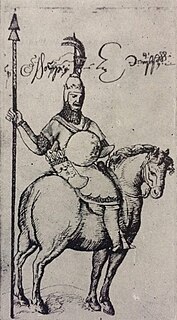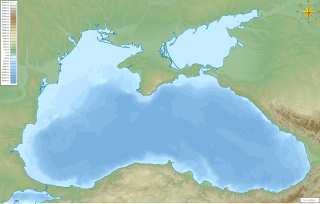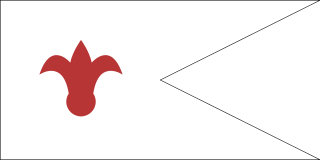Giorgi III Gurieli, of the Georgian House of Gurieli, was Prince of Guria from 1669 to 1684 and King of Imereti from 1681 to 1683. He was energetically involved in civil wars in western Georgian polities, which he sought to bring under his sway. He was killed in battle while trying to recover the lost throne of Imereti.

Mamia III Gurieli, also known as Mamia the Great Gurieli or the Black Gurieli, of the western Georgian House of Gurieli, was Prince of Guria from 1689 to 1714. Involved in civil wars plaguing western Georgia, he became King of Imereti three times in the years of 1701, 1711–1712, and 1713–1714. After his first reign as king for a year in 1701, he abdicated the throne of Imereti, being unable to tolerate the influence of his father-in-law Giorgi Abashidze. Subsequent periods of his royal career was the result of a feud with Giorgi VII of Imereti. Mamia died while still sitting on the throne of Imereti, which then reverted to his rival Giorgi VII.
Giorgi IV Gurieli, of the House of Gurieli, was Prince of Guria from 1711 to 1726, and a king of Imereti in western Georgia in 1716. He was installed as regent of Guria by his father, Mamia III Gurieli, then the king of Imereti, in 1712. In 1716, he seized the crown of Imereti, but was forced to abandon the enterprise later that year. Returning to Guria, his rule was challenged by a faction of local nobility, which included his mother Elene and brother Kaikhosro III Gurieli. He was finally able to crush the opposition after making peace with Bezhan Dadiani, Prince of Mingrelia.
Vakhtang was a Georgian prince of the Bagrationi dynasty of the Kingdom of Imereti, a younger son of King Alexander II of Imereti by his wife Tamar.

Levan I Dadiani was a member of the House of Dadiani and ruler of Odishi, that is, Mingrelia, in western Georgia. He succeeded on the death of his father, Mamia III Dadiani, as eristavi ("duke") of Odishi and ex officio mandaturt-ukhutsesi of Imereti in 1533. Dadiani's break with the king of Imereti brought about his downfall and imprisonment in 1546. He was able to escape and regain his possessions, securing Ottoman support for his independence from Imereti.
Giorgi III Dadiani was Prince of Mingrelia, of the House of Dadiani, from 1572 to 1573 and again from 1578 until his death. He was a son and successor of Levan I Dadiani.
Mamia IV Dadiani was Prince of Mingrelia, of the House of Dadiani, from 1573 to 1578 and again from 1582 until his death. He was a younger son of Levan I Dadiani.

Manuchar I Dadiani was Prince of Mingrelia, of the House of Dadiani, from 1590 until his death. A younger son of Levan I Dadiani, he succeeded on the death of his elder brother, Mamia IV Dadiani.
Liparit III Dadiani was Prince of Mingrelia, of the House of Dadiani, from 1657 until being deposed in 1658.

Vameq III Dadiani was Prince of Mingrelia, of the House of Dadiani, from 1658 until being deposed in 1661. He was also briefly King of Imereti in 1661. He assumed both Mingrelian and Imeretian thrones and lost them during a messy civil war in western Georgian polities and was killed by assassins while hiding in a refuge of the mountains of Svaneti.
Levan III Dadiani, born Shamadavle (შამადავლე) was Prince of Mingrelia, of the House of Dadiani, from 1661 to 1680. His reign unfolded against the background of a series of civil wars in western Georgian polities, in which Levan III was an opponent of King Bagrat V of Imereti to whom he lost a battle and his own wife.
Levan IV Dadiani was Prince of Mingrelia from 1681 until 1691, when he was forced to abdicate and retire to Constantinople, where he died. A natural son of the preceding Levan III Dadiani, he was the last of the First House of Dadiani to rule Mingrelia, a principality in western Georgia. The succeeding dynasty were the Chikovani, who assumed the surname of Dadiani and continued to rule Mingrelia until 1867.
Giorgi II Gurieli, of the House of Gurieli, was Prince of Guria from 1564 to 1583 and again from 1587 to 1600. Succeeding on the death of his father Rostom Gurieli, Giorgi's rule over his small principality, located in southwest Georgia, was a period of conflict with the neighboring Dadiani of Mingrelia and increasing assertiveness of the Ottomans whom Gurieli submitted in 1581. His reign was interrupted, from 1583 to 1587, by a Mingrelian invasion, but Giorgi was able to resume the throne with Ottoman support.
Mamia II Gurieli, of the House of Gurieli, was Prince of Guria from 1600 until his death at the hands of his own son Simon in 1625. Mamia's rule over his small principality, located in southwest Georgia, saw efforts to rebuff encroachments of the Ottoman Empire, with which he was forced to make peace in 1614, conceding the loss of territories and placing Guria under the obligation of paying tribute.

Simon I Gurieli, of the House of Gurieli, was Prince of Guria from 1625 to 1626. He acceded to power in Guria, a small principality in southwest Georgia, after having murdered his father, Mamia II Gurieli, and was dethroned and blinded by his brother-in-law Levan II Dadiani, Prince of Mingrelia. Simon thereafter became a monk and retired to Jerusalem.
Mamia IV Gurieli, of the western Georgian House of Gurieli, was Prince of Guria from 1726 to 1756 and again from 1758 to 1765 and from 1771 to 1776. Intermissions of his rule was the result of Mamia's rivalry with his younger brother, Giorgi V Gurieli, and complex political situation in the region, including the Ottoman encroachments and efforts by the kings of Imereti to bring western Georgian polities under their supreme authority.
Giorgi V Gurieli, of the western Georgian House of Gurieli, was Prince of Guria from 1756 to 1758 and again from 1765 to 1771 and from 1776 to 1788.
Invasion of Jiketi the remarkable event of Grand-duke of Odishi, Mamia III Dadiani (c.1512-1533), which resulted by defeat of allied forces, in 31 January 1533.














